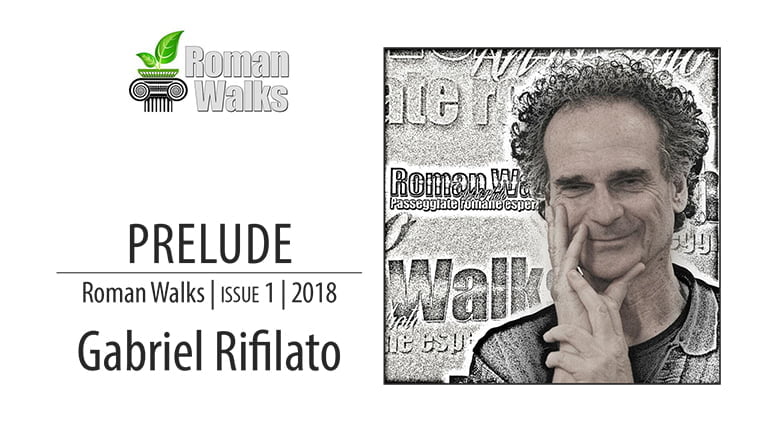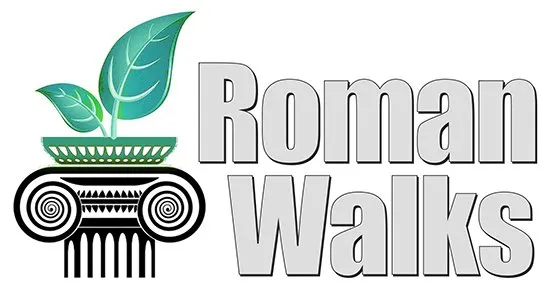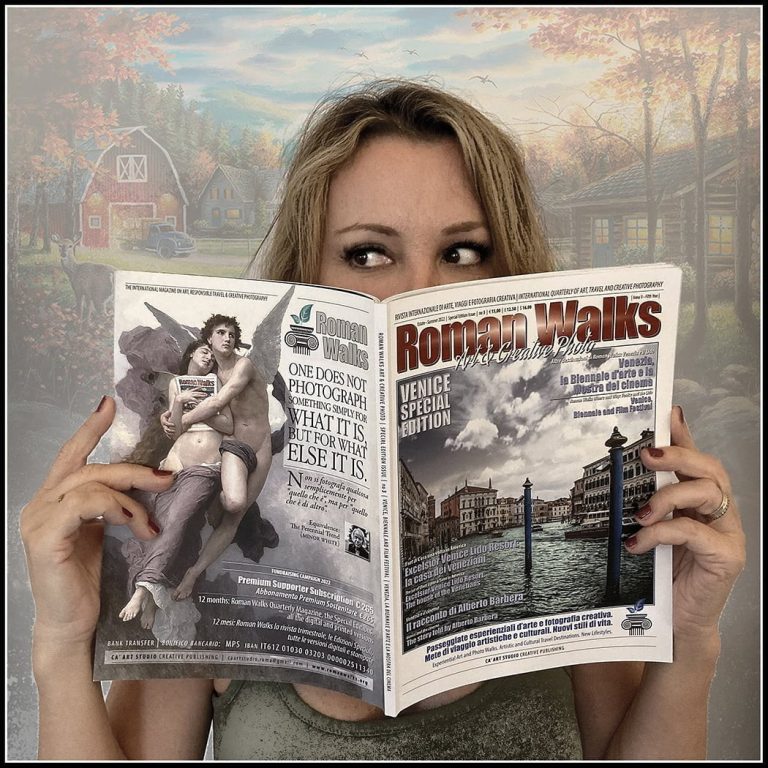Welcome to our – and your – new magazine Roman Art & Photo Walks.
Our editorial baptism took place on December 1st, 2018, and the first issue of Roman Walks was sent out to newsagents, libraries and tourist attractions, as well as being made available on the Internet.
The project for this quarterly magazine on Rome, art, culture and creative photography, was presented to the public after much exploration and research, which we were busy with throughout 2018. Our Studio first met with the Lozzi publishing house in December 2017, at the Più libri più liberi book fair, after which the issue you are now looking at began to take shape. The decisive meeting took place on June 9th, 2018, at the Gianicolo Hotel in Rome, during which we laid the foundations that would unite the Ca ‘Art Studio, our creative photography factory established by Floriana Cason and the undersigned, Edizioni Lozzi, owned by Roberto Lozzi, and the newspaper La Notizia, owned by Gaetano Pedullà.
During our hard work over the past six months, we began to look at the commitment, accuracy, detail and meticulousness required to produce this first issue, as being similar to that required by Tibetan monks when making a sand mandala. Now that you have the magazine in your hand, our work is done. We have to wipe the slate clean and start over. This is the transitory nature of material life. Impermanence. Now there is the second issue of the magazine to think about (out March 1st, 2019).
“The butterfly”, as Rabindranath Tagore says, “counts not months but moments, and has time enough”.
Roman Walks is inspired by Alfred Stieglitz’s Camera Work and the pictorial style that characterised the history of photography in the late nineteenth and early twentieth centuries.
“My passion for Photography is greater than ever and Camera Work is mad. All that’s born of spirit seems mad in these days of materialism run riot” (Alfred Stieglitz).
The initial idea for this magazine only became an editorial project after about a decade of creative photography workshops in Rome, which – for the most part – were expressed through the Neo-Pictorialist style of our images, photographic art exhibitions with tableaux vivants, and staged photography, at the Tordinona Theatre in Rome, alongside Art and Photography Walks including an “enviromental portrait”, in the old city centre.
A prototype of this publication was created in 2013, under the title “The Unknown Side of Photography”, and the Image Factory was the result of this experience. With its programmatic Manifesto, the Factory chose its style – using expressive methods that are the opposite to reportage – and its vocation, which is to “represent reality” and to adhere to the same pictorial vision that made the camera a creative tool in the hands of an artist – like a paintbrush and a canvas in the hands of a painter, or a chisel and marble in the hands of a sculptor: “the representation of one’s own ideas and one’s own vision of reality”.
“Impressionism has induced that we all see differently; it has done good to photography by showing that we should represent what we see and not what the lens sees. We see exactly what we are trained to see, and, if we are lucky, perhaps a little more but not much. We should be very careful what we learn”. (Henry Peach Robinson).
By choosing this path, it was natural to come across American photographer Minor White, a continuer of Stieglitz’s ideology, and to agree with Man Ray’s artistic ideas (“Art is not photography”) and Betty Edwards’ theories (“Seeing is the problem”), or Michael Michalko’s paradoxes (“We can complain that rose bushes have thorns, or rejoice because thorns have rose bushes”). This atlas of “creative thought” in art, and of how to transform the creation of images (that banal “take a picture”) into a tool to change oneself, to metamorphosize, is found in the articles of our magazine, and perhaps represents the main message which we would like to launch with Roman Walks; a creation that is aware of James Hillman’s (and Plato’s) daemon.
A few pages of the magazine are dedicated to photos taken by the Image Factory, with the idea of opening a discussion forum for readers and your ideas on visual art and photography.
In the first issue, art historian Bruna Condoleo and photographer Livia Mazzani respond to Man Ray’s provocative question What makes a photo beautiful?, proposing their choice of images. Next up are the Factory’s photographers, who create their Stories behind the images based on Gustav Flaubert’s thoughts on Rome.
Send us your comments and photos so we can start a debate about Man Ray and give us your thoughts on those of Flaubert. We will publish your contributions on the magazine’s website (www.romanwalks.org) and in the “Readers’ Letters” section in next spring’s issue.
The 28 pages of Roman Art & Photo Walk is the most interesting and fascinating part of the magazine: a monographic, collectible insert, with the first of twelve walks in the heart of Rome (the work plan is published on the back of the pull-out poster of the Trevi Fountain), in search of the vices and virtues of the Eternal City and the artist within us.
Will take you on a non-stop adventurous journey to the Trevi Fountain, guided by none other than an eighteenth century artist (find out who he is): how to photograph the Trevi District and the Aqua Virgo aqueduct, what remains of La Dolce Vita, the churches and the water in Respighi’s symphonies, the coins tossed into the fountain’s basin and the Lovers’ Fountain. Dozens of photos, with comments from the photographers themselves, aimed at inspiring you, our readers, and inviting you to do “better than us”. Read and send us your comments and, above all, your photos to publish.
Our Image Factory and this magazine are born in Rome.
In Rome, as our friend Cesare De Bartolomei loves to say, you never know what you might find under a sampietrino paving stone. But we are not fanatical about this city, nor do we think it is “the most beautiful city in the world”; we don’t claim primacy, nor do we sing its praises; we do not delight in the gentle “ponentino” breeze or “the blond” Tiber, but we do have the dignity of Roman artists and intellectuals who – horrified by the amount of rubbish and number of potholes – would like to go back to feeling proud to have been born in Rome. The dignity of people who knew and experienced Rome as a place filled with creativity, tolerance, entertainment, spirituality, well-being and history. A Rome, as our friend Luca Verdone says in his fascinating interview, that they would like to go back to believing in.
So that we can meet, get to know each other and exchange ideas, why not visit our photographic art exhibition The Vices and Virtues of Rome, which will be held in December at the Monogramma art gallery (Via Margutta 102), where the magazine presentation took place. From January 2019, the exhibition will be on show in the foyer of the Tordinona Theatre (Via degli Acquasparta 16).
You can also participate in our Photo Walk to the Trevi Fountain with your DSLRs or smartphones, together with your companions, either in December 2018 or February 2019: you will discover unexpected things about Rome and, above all, you will learn all about photography and the environmental portrait, together with our Image Factory photographers.
Finally, you can meet us to talk about Rome, art and photography at Together Mansion (Viale Glorioso 14): here you can take part in one of our photographic tableaux vivants, based on the style of a “living” performance, on December 2nd, 2018: The Romans of the Decadence, by Thomas Couture.
We hope you enjoy this first issue of Roman Art & Photo Walks.
At a certain point in Woody Allen’s film “To Rome with Love”, Jack says: “It’s incredible that the Colosseum is still standing after thousands of years. You know, Sally and I have to re-tile the bathroom every six months”.
The Americans find Rome’s eternity disconcerting… The first issue of Roman Walks dedicates this winter’s “most important artistic event” to Andy Warhol, whose current exhibition will be in Rome until February 3rd, 2019. And therefore I would like to leave you with his words (below). Although first I would like to thank you for choosing to read this issue and hope that you continue to “stay connected”.
Gabriel Rifilato
caartstudio.roma@gmail.com
“They call Rome The Eternal City because everything is so old and everything is still standing. They always say, Rome wasn’t built in a day. Well, I say maybe it should have been, because the quicker you build something, the shorter a time it lasts, and the shorter a time it lasts, the sooner people have jobs again, replacing it. Replacing necessities keeps people busy. The necessities, they always say, are food, shelter, and clothing. Now, in Italy they make a lot of food, and they make a lot of clothing, but food and clothing are only two-thirds of the necessities, the other third is shelter – and they’re not making that because it’s already been made. So what’s happened in Rome is that the women wind up in the kitchens making all the food and in the factories sewing all the clothes, while the men don’t do anything because the buildings are already built and they’re not falling down! This is why you see so many men on the streets of Rome, Italy, at all hours of the day and night.
Based on “The philosophy of Andy Warhol”



